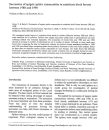Bibliografie
Liming alters body size distribution in a community of epigeic spiders in birch forest (Betula pendula Roth). 2018
- Autoři
- prof. Ing. Emanuel Kula, CSc., Ing. Ondřej Košulič, Ph.D., Mgr. Radek Michalko, Ph.D.
Are arboreal spiders associated to particular tree canopies? 2011
- Autoři
- prof. Ing. Emanuel Kula, CSc., doc. Mgr. Stanislav Korenko, Ph.D., prof. Mgr. Stanislav Pekár, Ph.D.
- Abstrakt
- Originalni ID: 971
Influence of liming on the epigeic spider (Araneae) community ofthe Krušné hory Mts. (Czech Republic) 2008
- Autoři
- prof. Ing. Emanuel Kula, CSc., Michal Holec, doc. Mgr. Stanislav Korenko, Ph.D.
- Abstrakt
- Originalni ID: 762
Succession of epigeic spider communities in substitute birch forests between 1988 and 1998. 2002
- Autoři
- prof. Ing. Emanuel Kula, CSc., doc. Mgr. Vítězslav Bryja, Ph.D.
- Abstrakt
- We investigated spider fauna in 6 substitute birch stands in northern Bohemia between 1988 and 1998 in areas destroyed by air pollution. Spiders were caught using either pitfall traps or photoeclectors and each collecting method was evaluated separately. The comparison of results from year 1988 and year 1998 showed an increase in number of individuals but not in number of species. Although no clear trends were found when comparing the data by biodiversity indexes, two distinct clusters separating localities in 1988 and 1998 were found when comparing spider communities by Soerensen's index and cluster analysis. Based on these data we identified species mainly responsible for such changes. Our stud y shows that although biodiversity evaluated by biodiversity indexes and number of species was not changed during ten years of succession, progressive changes in the spider community occur in its structure at the level of single species.
Statistiky
Nalezeno
8585
Nálezy
254
Druhy
130
Rody
8
Čtverce






